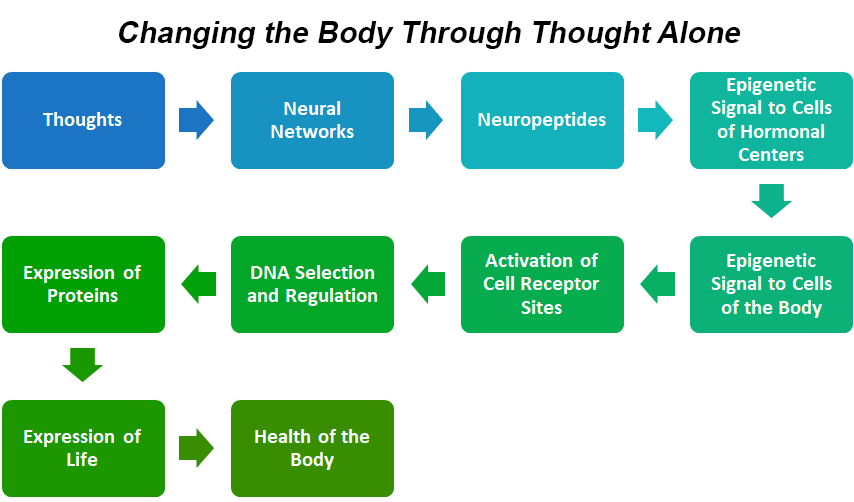A few years ago, I attended a talk by Dr. Lisa Rankin and found my way to her New York Times best-selling book Mind Over Medicine. She made the argument that we can heal ourselves by the power of thought and provided research to back it up. I’m taking a deeper dive on the subject through the aegis of Dr. Joe Dispenza’s You Are The Placebo: Making Your Mind Matter.
Dispenza tells us that our bodies are phenomenal apothecaries. They produce a wide array of substances that maintain our biological systems, remodel bones, heal wounds, respond to threat, avert pain, foster sleep, enhance immune function, elevate mood, and so on. This marvelous machinery can keep us in fine fettle without pharmaceuticals. However, to function at peak efficiency, we need to manifest the right physical, mental, and emotional energy.
As discussed in an earlier post on epigenetics, we are not held hostage by our genetic endowments. Environmental factors play a significant role in genetic expression. In fact, the overwhelming majority of our genes activate (or deactivate) based on what we think, feel, do, express, ingest, or experience. Of course, to the extent that we perceive our lives through a fixed lens and react to circumstances with the same neural architecture, we will head toward a very specific genetic destiny. But if we are willing to adjust our beliefs, perceptions, and interactions with the environment, we can chart a different course.
Dr. Dispenza provides a simple flow diagram to trace the connection between thoughts and bodily well-being. Let’s work through this flow with a concrete example.
Suppose I have an upcoming meeting with a co-worker who has consistently been a thorn in my side and whose behavior has proven disruptive to my team’s work. Based on past experience, my thoughts about the meeting trigger an expectation of conflict. My neural network releases chemical messengers (neuropeptides) that trigger the production of the stress hormone cortisol. With a hefty dose of cortisol coursing through my veins, cell receptor sites trigger intracellular environments that upregulate DNA expression in a way that mobilizes energy (glucose), elevates heart rate, blood pressure, and breathing, halts tissue growth and repair, boosts immune response, blunts pain receptors, and sharpens sensory perception. This state proves protective when induced by a bona fide threat of short duration. But it results in diminished health when sustained for an extended period of time.
Thoughts, emotions, and events act like epigenetic engineers. They control our physiological responses. And here’s the kicker: Our bodies cannot distinguish between having an experience and just thinking about one. A scary movie can get us just as juiced up as a physical threat. On the downside, it’s a call to avoid unnecessary stimulation in our entertainment choices. On the upside, it provides a mechanism to set an intention to be healthy, craft a mental picture of that state, and think our way into positive outcomes.
A new field called psychoneuroimmunology explores the effect of thoughts and emotions on the immune system. For example, laughter causes the production of chemical messengers that dock on the cellular wall. Receptors respond to the electromagnetic energy and stimulate the production of anti-inflammatory proteins epigenetically to quelch infection. Fancy that!
If we want to reap the benefits of forwarding thoughts, emotions, and actions, we may need to rewire our neural pathways. Neurons make and break connections in our brains dynamically. The more we repeat thoughts and behaviors, the stronger the neural connections, and the more automatic they become. As such, it should come as no great surprise that of the tens of thousands of thoughts that cross our minds daily, 90% are the same as the previous day. These recurrent thoughts drive the same behaviors which yield the same experiences, emotions, and biochemicals and give rise to the same health-affecting gene expression. If we want to establish new patterns, we need to break old habits.
Expectations play a powerful role in health outcomes. As noted in Dr. Rankin’s work, patients who believe that a drug or treatment will help them generally get positive results even if they’re given a placebo. Among other things, placebos can trigger the release of endorphins, the body’s natural pain killer. This phenomenon also works in reverse. Patients expecting bad results usually get them (a.k.a., the nocebo effect). In case studies of patients with terminal illness, those who refused to accept their grim prognoses and remained optimistic experienced better outcomes than those who surrendered to their diseases. Deep-seated positivity drove a new set of thoughts which opened up new possibilities. If we want to avail ourselves of this form of physiological programming, our belief in the power of thought must take root at a conscious and subconscious level.
We can also shape our destiny with the power of intention. By conscious choice, we can give our actions and experiences new meaning and thereby install new “wiring.” For example, when we engage in a daily recounting of things for which we are grateful, our minds tend to be on the lookout for things to add to our lists. As Bing Crosby told us in a hit song of 1945:
You’ve got to accentuate the positive
Eliminate the negative
Latch on to the affirmative
Don’t mess with Mister In-Between
